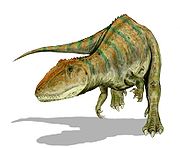
Erlhaz Formation
Encyclopedia
The Echkar Formation is a geological formation in Niger whose strata date back to the Late Cretaceous
(Cenomanian
stage, about 93 million years ago). Dinosaur remains are among the fossils that have been recovered from the formation.
Late Cretaceous
The Late Cretaceous is the younger of two epochs into which the Cretaceous period is divided in the geologic timescale. Rock strata from this epoch form the Upper Cretaceous series...
(Cenomanian
Cenomanian
The Cenomanian is, in the ICS' geological timescale the oldest or earliest age of the Late Cretaceous epoch or the lowest stage of the Upper Cretaceous series. An age is a unit of geochronology: it is a unit of time; the stage is a unit in the stratigraphic column deposited during the corresponding...
stage, about 93 million years ago). Dinosaur remains are among the fossils that have been recovered from the formation.
Sauropsids
| Archosaurs of the Echkar Formation | ||||||
|---|---|---|---|---|---|---|
| Genus | Species | Location | Stratigraphic position | Material | Notes | Images |
Anatosuchus Anatosuchus Anatosuchus is an extinct genus of notosuchian crocodylomorph discovered in Gadoufaoua, Niger, and described by a team of palaeontologists led by the American Paul Sereno in 2003, in the Journal of Vertebrate Paleontology... |
A. minor |
Lower |
 |
|||
Carcharodontosaurus Carcharodontosaurus Carcharodontosaurus was a gigantic carnivorous carcharodontosaurid dinosaur that lived around 100 to 93 million years ago, during the late Albian to early Cenomanian stages of the mid-Cretaceous Period... |
C. iguidensis |
|||||
Kaprosuchus Kaprosuchus Kaprosuchus is an extinct genus of mahajangasuchid crocodyliform. It is known from a single nearly complete skull collected from the Upper Cretaceous Echkar Formation of Niger. The name means "boar crocodile" from the Greek kapros and souchos in reference to its unusually large caniniform teeth... |
K. saharicus |
|||||
Laganosuchus Laganosuchus Laganosuchus is an extinct genus of stomatosuchid crocodyliform. Fossils have been found from Niger and Morocco and date back to the Upper Cretaceous. The name means "pancake crocodile" from the Greek laganon and souchos in reference to the shallow depth of the skull, which is characteristic of... |
L. thaumastos |
|||||

